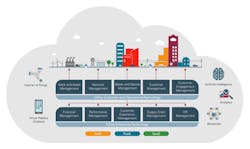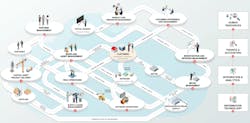A Modern IoT Platform for Your Modern, Customer-Centric Utility
Today’s utilities are contending with the weighty pursuit of transforming a firmly traditional business model into a modern, customer-centric enterprise.
It’s no secret that increasingly hard-driving customer expectations are influencing the shift. In addition to the usual demands, such as faster response time when an issue occurs, customers are raising the bar – if you can detect the issue in advance, you should be able to let them know about it in advance. Or better yet, prevent it from occurring in the first place. They’d like digitally interactive services, such as a mobile app and a web portal with a Chabot, and have clear preferences about how they’d like to receive your communications. If other service providers can support their requests, customers point out, so too should utilities.
Progress is being made, certainly, as you’re exploring how data can help you learn about your customers, to then create and deliver services that meet their needs. You’ve installed smart meters, sensors and devices to generate the data, with the intent to gain greater visibility into usage patterns and preferences. What you’ve discovered, however, is that installing the IoT equipment and collecting the data is just the first step in an important lineup. Now it’s about figuring out which IoT technologies you’ll need for the rest of the lineup so you can keep your progress going.
Benefits of a Modern IoT Platform
IoT has been around for many years, and its potential to help utilities transform their business is creating a buzz. In short, a proper IoT platform not only captures the data, but it manages each step of the IoT journey. It moves the data to the best application for analysis then delivers the insights learned across the organization to the right person at the right time. Ideally each organizational function has access to the information to create actionable insights and incorporate these insights into their business applications and workflows. The insights allow the utilities to be much more responsive to customer issues, and address the issues proactively.
An example is a customer’s meter that’s on the brink of failure. As soon as the signal is detected, the IoT platform raises a red flag. The data is sent to a service team so they can communicate with the customer. They see in her profile that she prefers texts instead of phone calls, so texting begins. The operations team also receives the information, after which they order a new meter; the installation team is alerted as well to schedule the installation appointment; and because they also have access to her profile and preferences, they schedule the appointment through the mobile app. The meter is installed, the customer service team follows up with a final text, and the red flag disappears – all without the customer picking up the phone.
The IoT platform detected the pending meter failure and managed the flow of that data to the right people and functions throughout the utility at the right time to perform the correct actions. Issue averted, which saved time and expenses for the organization and eliminated any potential inconvenience for the customer. Plus, that customer is extremely pleased that communications were done through the channels she prefers.
Key Considerations to Get Started
When you focus on data to help you build a more customer-centric business model, every step in your strategy and execution matters. If you’re building out your IoT platform or beginning due diligence to bring one in, consider these recommendations.
- Ensure visibility and control. An integrated, cloud-based IoT platform with AI and machine learning technology gives you visibility, i.e. foresight, into what’s happening on your system so you can proactively, not just reactively, take action. Having control of these actions means you can decide what to do next—stay the course or change it based on your end goals. Your decision can positively guide the outcome, which enables better customer service and results in greater customer satisfaction.
- Optimize the flow and use of data. Those thinking about data and data flows need to think about integrating the data across the organization, not keeping it in disparate silos. An integrated, cloud-based IoT platform will help you physically do this. From there, you can understand how the data flows across your utility and how data in one function impacts another. Providing each functional team with this type of access gives them the opportunity to stay ahead of issues and provide exceptional service, regardless of where they sit in the organization.
- Choose a vendor with a comprehensive platform. A vendor with a full suite of cloud-based applications can provide knowledge about each functional area within your utility—where each application resides, how they all connect, and how they interact with other applications and functions. The applications, along with related services and offerings, can be streamlined and save you significant costs on set up, operations and future expansion.
Pave Your IoT Path, Keep Your Customers Happy
Data is everywhere, and IoT can bring it all together. Everything is connected and always on—this we know and embrace, as it’s what launches the pursuit toward becoming a more modern, customer-centric enterprise. Several utilities are adopting an integrated IoT platform to help drive this pursuit; others continue to explore the possibilities. Wherever you are in your journey, be persistent about forging the best path for your organization. And remember, it’s all about expectations and services—in addition to addressing what’s needed today, you’ll need to keep up with all that’s new tomorrow. Your relationship with your customers is counting on it.
About the Author
Brian Bradford
Brian Bradford is vice president of industry solutions at Oracle.


